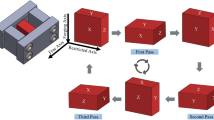Abstract
Manufacturing of nanostructured Ti-6Al-4V via a novel severe plastic deformation (SPD) method, named “multi-axial-temperature forging (MATF)” and study of its microstructure and some of its mechanical properties were the aims of this research. In this new technique, known multi-axial forging (MAF) method was developed by a multi-temperature procedure for producing nanostructure in rather brittle materials. Due to room-temperature workability limits and in order to prevent low-temperature embrittlement in Ti-6Al-4V, MATF process was started at elevated temperature of 725 °C, but in order to attain the smallest possible grain size, deformation temperature at subsequent passes was gradually decreased in steps of 75 °C. Grain refinement due to application of MATF was investigated using scanning electron microscopy (SEM). The results show that this process can severely refine the microstructure. The refinement occurred at a variable rate, so that it was significant at the first pass, but reduced substantially at subsequent passes. The average grain size of the final product obtained after the fourth pass was about 100 nm. The results of shear punch and hardness tests show that application of MATF process significantly increased the yield strength up to 50 %, ultimate strength up to 45 %, and hardness up to 26 % relative to those of the as-cast alloy, but it reduced its elongation slightly. The results of this research also show that MATF process facilitates production of nanostructure in low-temperature brittle materials like Ti-6Al-4V alloy by means of SPD techniques.
Similar content being viewed by others
References
Valiev RZ, Estrin Y, Horita Z, Langdon TG, Zechetbauer MJ, Zhu YT (2006) Producing bulk ultrafine-grained materials by severe plastic deformation. JOM 58(4):33–39
Azushima A, Kopp R, Korhonen A, Yang D, Micari F, Lahoti G, Groche P, Yanagimoto J, Tsuji N, Rosochowski A (2008) Severe plastic deformation (SPD) processes for metals. CIRP Ann Manuf Technol 57(2):716–735
Valiev RZ, Islamgaliev RK, Alexandrov IV (2000) Bulk nanostructured materials from severe plastic deformation. Prog Mater Sci 45(2):103–189
Kapoor R, Sarkar A, Yogi R, Shekhawat S, Samajdar I, Chakravartty J (2013) Softening of Al during multi-axial forging in a channel die. Mater Sci Eng A 560:404–412
Padap A, Chaudhari G, Pancholi V, Nath S (2010) Warm multiaxial forging of AISI 1016 steel. Mater Des 31(8):3816–3824
Mukhtarov S, Ermachenko A (2012) Influence of severe plastic deformation and heat treatment on microstructure and mechanical properties of a nickel-iron based superalloy. Rev Adv Mater Sci 31:151–156
Nie K, Wang X, Hu X, Wu Y, Deng K, Wu K, Zheng M (2011) Effect of multidirectional forging on microstructures and tensile properties of a particulate reinforced magnesium matrix composite. Mater Sci Eng A 528(24):7133–7139
Lütjering G, Williams JC (2003) Titanium, vol 2. Springer, New York
Dieter GE, Kuhn HA, Semiatin SL (2003) Handbook of workability and process design. ASM international
Guduru R, Darling K, Kishore R, Scattergood R, Koch C, Murty K (2005) Evaluation of mechanical properties using shear–punch testing. Mater Sci Eng A 395(1):307–314
Toloczko M, Hamilton M, Lucas G (2000) Ductility correlations between shear punch and uniaxial tensile test data. J Nucl Mater 283:987–991
Guduru RK, Murty KL, Youssef KM, Scattergood RO, Koch CC (2007) Mechanical behavior of nanocrystalline copper. Mater Sci Eng A 463(1):14–21
Hosseini E, Kazeminezhad M (2009) Nanostructure and mechanical properties of 0–7 strained aluminum by CGP: XRD, TEM and tensile test. Mater Sci Eng A 526(1):219–224
Roters F, Raabe D, Gottstein G (2000) Work hardening in heterogeneous alloys—a microstructural approach based on three internal state variables. Acta Mater 48(17):4181–4189
Dieter GE, Bacon D (1986) Mechanical metallurgy, vol 3. McGraw-Hill, New York
Meyers MA, Mishra A, Benson DJ (2006) Mechanical properties of nanocrystalline materials. Prog Mater Sci 51(4):427–556
Kumar SS, Raghu T (2013) Mechanical behaviour and microstructural evolution of constrained groove pressed nickel sheets. J Mater Process Technol 213(2):214–220
Zherebtsov S, Kudryavtsev E, Kostjuchenko S, Malysheva S, Salishchev G (2012) Strength and ductility-related properties of ultrafine grained two-phase titanium alloy produced by warm multiaxial forging. Mater Sci Eng A 536:190–196
Zhao Y, Zhu Y, Lavernia EJ (2010) Strategies for improving tensile ductility of bulk nanostructured materials. Adv Eng Mater 12(8):769–778
Shin DH, Park J-J, Kim Y-S, Park K-T (2002) Constrained groove pressing and its application to grain refinement of aluminum. Mater Sci Eng A 328(1):98–103
Krishnaiah A, Chakkingal U, Venugopal P (2005) Applicability of the groove pressing technique for grain refinement in commercial purity copper. Mater Sci Eng A 410:337–340
Khodabakhshi F, Kazeminezhad M, Kokabi A (2010) Constrained groove pressing of low carbon steel: nano-structure and mechanical properties. Mater Sci Eng A 527(16):4043–4049
Kumar SS, Raghu T (2011) Tensile behaviour and strain hardening characteristics of constrained groove pressed nickel sheets. Mater Des 32(8):4650–4657
Sajadi A, Ebrahimi M, Djavanroodi F (2012) Experimental and numerical investigation of Al properties fabricated by CGP process. Mater Sci Eng A 552:97–103
Sakai T, Belyakov A, Kaibyshev R, Miura H, Jonas JJ (2014) Dynamic and post-dynamic recrystallization under hot, cold and severe plastic deformation conditions. Prog Mater Sci 60:130–207
Rafizadeh E, Mani A, Kazeminezhad M (2009) The effects of intermediate and post-annealing phenomena on the mechanical properties and microstructure of constrained groove pressed copper sheet. Mater Sci Eng A 515(1):162–168
Author information
Authors and Affiliations
Corresponding author
Rights and permissions
About this article
Cite this article
Fallah Ghanbari, B., Arabi, H., Abbasi, S.M. et al. Manufacturing of nanostructured Ti-6Al-4V alloy via closed-die isothermal multi-axial-temperature forging: microstructure and mechanical properties. Int J Adv Manuf Technol 87, 755–763 (2016). https://doi.org/10.1007/s00170-016-8343-8
Received:
Accepted:
Published:
Issue Date:
DOI: https://doi.org/10.1007/s00170-016-8343-8




